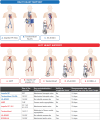Management of cardiogenic shock: state-of-the-art
- PMID: 39254735
- PMCID: PMC11541372
- DOI: 10.1007/s00134-024-07618-x
Management of cardiogenic shock: state-of-the-art
Abstract
The management of cardiogenic shock is an ongoing challenge. Despite all efforts and tremendous use of resources, mortality remains high. Whilst reversing the underlying cause, restoring/maintaining organ perfusion and function are cornerstones of management. The presence of comorbidities and preexisting organ dysfunction increases management complexity, aiming to integrate the needs of vital organs in each individual patient. This review provides a comprehensive overview of contemporary literature regarding the definition and classification of cardiogenic shock, its pathophysiology, diagnosis, laboratory evaluation, and monitoring. Further, we distill the latest evidence in pharmacologic therapy and the use of mechanical circulatory support including recently published randomized-controlled trials as well as future directions of research, integrating this within an international group of authors to provide a global perspective. Finally, we explore the need for individualization, especially in the face of neutral randomized trials which may be related to a dilution of a potential benefit of an intervention (i.e., average effect) in this heterogeneous clinical syndrome, including the use of novel biomarkers, artificial intelligence, and machine learning approaches to identify specific endotypes of cardiogenic shock (i.e., subclasses with distinct underlying biological/molecular mechanisms) to support a more personalized medicine beyond the syndromic approach of cardiogenic shock.
Keywords: Assist device; Cardiogenic shock; Heart failure; Intensive care; Myocardial infarction; Outcome.
© 2024. The Author(s).
Conflict of interest statement
CJ reports institutional grants by the German research foundation, German ministry for economy and energy, State of Nordrhine-Westfalia, German space agency, European Union and Edwards Lifescience as well as speaker fees outside the field of this article by Bristol Myers Squibb, Daichi Sankyo and Boehringer-Ingelheim. RRB: no conflict of interest. MJ: no conflict of interest. SP: no conflict of interest. KAK reports speaker fees received from Daiichi Sankyo, Zoll Medical, Amarin, consulting fees by Amarin, Novartis, Sanofi and travel support provided by Amgen, Sanofi and Daiichi Sankyo. KR reports that he is the current Chair of Publications at the Extracorporeal Life Support Organisation. JD: no conflict of interest. JF: no conflict of interest. Clement Delmas reports lectures and consulting fees received by Abiomed and Abott. A-AM: no conflict of interest. HT: no conflict of interest. SS: no conflict of interest.
Figures



References
-
- van Diepen S et al (2017) Contemporary management of cardiogenic shock: a scientific statement from the american heart association. Circulation 136(16):e232–e268 - PubMed
-
- Herrick JB (1983) Clinical features of sudden obstruction of the coronary arteries. JAMA 250(13):1757–1762 - PubMed
-
- Stead EA, Ebert RV (1942) Shock syndrome produced by failure of the heart. Arch Inter Med 69(3):369–383
-
- Zeymer U et al (2020) Acute cardiovascular care association position statement for the diagnosis and treatment of patients with acute myocardial infarction complicated by cardiogenic shock: a document of the acute cardiovascular care association of the European Society of Cardiology. Eur Heart J Acute Cardiovasc Care 9(2):183–197 - PubMed
Publication types
MeSH terms
Substances
LinkOut - more resources
Full Text Sources

